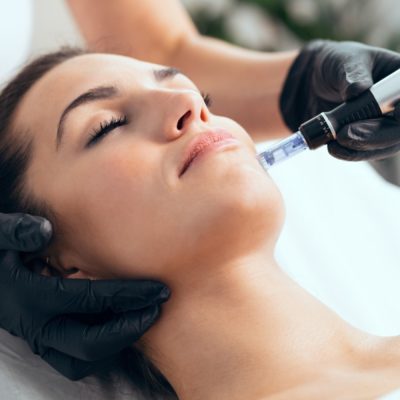Microneedling Radio Frequency (MNRF)
Microneedling Radio Frequency (MNRF) is an innovative cosmetic treatment combining the benefits of microneedling with radiofrequency energy. It helps to rejuvenate the skin, treat various skin conditions and improve overall texture and tone. It is a minimally invasive procedure, highly effective in promoting collagen production, tightening the skin and addressing concerns like acne scars, wrinkles and enlarged pores.

What is Microneedling Radio Frequency (MNRF)?
Microneedling Radio Frequency (MNRF) is a state-of-the-art skin rejuvenation technique that combines microneedling with radiofrequency (RF) energy. It involves creating tiny, controlled punctures in the skin using fine needles. This stimulates the skin’s natural healing process and collagen production. Combining it with RF energy enhances the effects of microneedling by delivering heat energy to deeper layers of the skin, promoting tighter and more youthful skin.
MNRF is an effective solution for various skin issues, including acne scars, fine lines, wrinkles, skin laxity, and uneven skin texture. It offers a safe, non-surgical alternative with minimal downtime and quick recovery when compared to traditional facelifts and other invasive procedures.
Method & Treatment of Microneedling Radio Frequency (MNRF)
How MNRF Works
MNRF devices are equipped with microneedles that penetrate the skin at controlled depths. Once the needles reach the prescribed depth, RF energy is delivered through the needles into the targeted areas of the skin. This combination of microneedling and RF energy stimulates collagen production and skin remodeling at multiple levels. This results in improved skin texture, firmness and overall appearance.
Treatment Procedure
Consultation & Skin Assessment
A thorough assessment of the patient’s skin condition is done to determine the suitability of MNRF. Also, the goals of the procedure and the patient expectations are discussed.
Preparation
The treatment area is properly cleaned to prevent infections. A topical numbing cream is then applied to minimize discomfort during the procedure. This cream is left on for about an hour, before being washed off.
MNRF Procedure
A handheld MNRF device is used to deliver controlled microneedling and RF energy to the targeted areas. The depth and intensity of the needles are adjusted based on the patient’s skin type and the specific concerns being addressed. The procedure typically takes between 20 to 30 minutes, depending on the treatment area.
Post-Treatment Care
After the procedure, a soothing serum or mask is applied to calm the skin and enhance the healing process. Patients can return to their regular activities with minimal downtime, although some redness or mild swelling may occur immediately after treatment.
Applied Areas of Microneedling Radio Frequency (MNRF)
MNRF can be used to treat various areas, including:
Face
For tightening skin, reducing acne scars, fine lines, and wrinkles, and improving overall texture and tone.
Neck
To address skin laxity and enhance the appearance of the neck.
Decolletage
To improve the texture and firmness of the skin on the chest
Hands
To reduce signs of aging, including wrinkles and skin laxity.
Body Areas
MNRF can also be used on the abdomen, thighs, and other areas to treat stretch marks, loose skin, and scars.
Precautions and Risks of Microneedling Radio Frequency (MNRF)
While MNRF is generally safe and well-tolerated by most people, certain precautions and risks include:
- A dermatologist will assess your skin to determine the suitability of MNRF for you.
- MNRF will not be performed on areas with severe acne, active infections or skin conditions like eczema or psoriasis.
- Excessive sun exposure should be avoided before and after the procedure to reduce the risk of hyperpigmentation.
- At times, patients may experience mild discomfort, redness, pinpoint bleeding or swelling during or after the procedure. However, these are temporary and typically subside within a few hours to days.
- In some rare cases, patients may experience prolonged redness, hyperpigmentation or infection. Ensuring to properly follow after-care instructions minimizes these risks.
Post-Procedure Signs to Look Out For
After having an MNRF procedure performed, it is important to monitor your skin and adhere to post-procedural care guidelines
provided by your doctor. Signs to look out for include:
Redness & Swelling: Some redness and mild swelling is normal immediately after treatment. It typically subsides within a few hours to days.
Avoid Sun Exposure: Protect your skin from direct sunlight and use a broad-spectrum sunscreen with high SPF to prevent hyperpigmentation.
Gentle Skincare Routine: Use gentle skincare products and avoid harsh exfoliants or active ingredients like retinoids for at least a week post-treatment.
Hydrate & Moisturize: Keep your skin well-hydrated and moisturized to support healing and enhance results.
Avoid Heat: Avoid using hot water or engaging in intense physical activities that may cause excessive sweating for a few days after treatment.
Complementary Cosmetic Procedures for Better Outcomes
MNRF can be paired with other cosmetic treatments to enhance results and address multiple skin concerns simultaneously.
Chemical Peels
To improve skin texture and tone by exfoliating dead skin cells and promoting cell turnover.
Facial Platelet-Rich Plasma (PRP) Therapy
To boost collagen production and accelerate healing when combined with MNRF.
